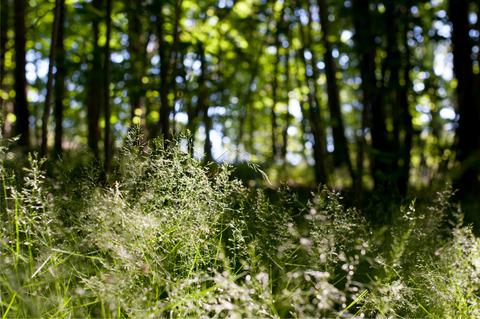Our official English website, www.x-mol.net, welcomes your feedback! (Note: you will need to create a separate account there.)
Biological flora of the British Isles: Poa nemoralis
Journal of Ecology ( IF 5.5 ) Pub Date : 2020-06-18 , DOI: 10.1111/1365-2745.13402 Jan Plue 1 , Sara A. O. Cousins 1 , Karen De Pauw 2 , Martin Diekmann 3 , Jenny Hagenblad 4 , Kenny Helsen 5 , Martin Hermy 6 , Jaan Liira 7 , Anna Orczewska 8 , Thomas Vanneste 2 , Monika Wulf 9 , Pieter De Frenne 2
中文翻译:

不列颠群岛的生物区系:Poa nemoralis
更新日期:2020-06-18
Journal of Ecology ( IF 5.5 ) Pub Date : 2020-06-18 , DOI: 10.1111/1365-2745.13402 Jan Plue 1 , Sara A. O. Cousins 1 , Karen De Pauw 2 , Martin Diekmann 3 , Jenny Hagenblad 4 , Kenny Helsen 5 , Martin Hermy 6 , Jaan Liira 7 , Anna Orczewska 8 , Thomas Vanneste 2 , Monika Wulf 9 , Pieter De Frenne 2
Affiliation

|
- This account presents information on all aspects of the biology of Poa nemoralis L. (Wood Meadow‐grass) that are relevant to understanding its ecological characteristics and behaviour. The main topics are presented within the standard framework of the Biological Flora of the British Isles : distribution, habitat, communities, responses to biotic factors, responses to environment, structure and physiology, phenology, floral and seed characters, herbivores and disease, history, and conservation.
- The grass Poa nemoralis is widespread and frequent to locally common across the British Isles, except for western and central Ireland, and northern Scotland. In both its native Eurasian range and introduced ranges in, for example, the Americas, its main habitat comprises temperate (mixed) deciduous woodland. The species finds important secondary habitats in hedgerows, as well as in non‐woodland vegetation such as on cliffs, screes and walls or sporadically in grassland and heathland. Although not always taxonomically or morphologically distinct units, the species is suspected to comprise many cytological races and hybrid polyploid populations with variable morphology. Morphological variation among P. nemoralis populations may also be a sign of local environmental adaptation or a result of introgressive hybridization with other, morphologically variable members of Poa section Stenopoa such as P. glauca , P. compressa or P. pratensis .
- Poa nemoralis is a small‐statured, loosely caespitose grass, with populations ranging from a few individual tufts to those visually defining the aspect of the herbaceous understorey. The species tolerates moderate to deep shade on the forest floor, yet it tends to forage for available light, occurring more and growing taller in canopy gaps, forest edges and hedgerows. The amount of light is central to its survival and reproductive ecology, being important for flower induction, seed production and seed germination. The species produces large quantities of small, light seeds which facilitate spatial and temporal dispersal.
- The species occupies a wide range of soil pH (3–7) and nutrient conditions (C/N ratio ranges between 10 and 25), though it clearly prefers moderately acid and somewhat drier soils with limited litter thickness, avoiding soils with mor humus types. Poa nemoralis displays distinct small‐scale acidifuge responses, being absent in areas of low soil pH (<3).
- Poa nemoralis is a moderately strong indicator of ancient woodland: it can quickly colonize recently established wooded areas adjacent to ancient woodland when it is not hindered by dispersal limitation and elevated nutrient levels. Nonetheless, dispersal limitation impedes rapid colonization of isolated, recently established woodlands, in spite of ample records of zoochorous seed dispersal. While currently frequent to locally common, the species is at risk if ancient woodlands continue to decline in its native Eurasian range. Across N.W. Europe, it is already in moderate decline in temperate deciduous ancient woodlands because of acidification, eutrophication and darkening of the forest understorey. In its introduced ranges, it is considered invasive.
中文翻译:

不列颠群岛的生物区系:Poa nemoralis
- 该科目介绍了与草地早熟禾(Wood Meadow-grass)生物学有关的所有方面的信息,这些方面与了解其生态特征和行为有关。主要主题是在不列颠群岛生物区系的标准框架内介绍的:分布,栖息地,社区,对生物因子的响应,对环境,结构和生理的响应,物候,花和种子特征,草食动物和疾病,历史,和保护。
- 除西部和中部爱尔兰以及苏格兰北部外,整个不列颠群岛广泛分布着草波阿尼莫拉利草。在其原始的欧亚山脉和例如美洲的引入山脉中,其主要栖息地包括温带(混合)落叶林地。该物种在树篱以及非林地植被中(例如悬崖,熨平板和墙壁上)或在草地和荒地中零星地发现重要的次生栖息地。尽管并非总是在分类学或形态学上不同的单位,但该物种被怀疑包含许多细胞学种族和形态多样的杂种多倍体种群。假单胞菌的形态变化群体也可以是局部环境适应的标志或与其他,形态可变构件渐渗杂交的结果早熟部Stenopoa如P.青冈,P.牛鞭或草地早熟禾。
- 早熟禾(Poa nemoralis)是一种矮小的,松散的树皮草,种群数量从数个单独的簇到在视觉上定义草皮下层植物方面的人群。该树种在森林地上能忍受中度到深层的阴影,但它倾向于觅食可用的光,在树冠间隙,森林边缘和树篱中出现的次数更多,并且越来越高。光线的数量对于其生存和生殖生态至关重要,对于花卉诱导,种子生产和种子发芽至关重要。该物种产生大量小而轻的种子,有利于时空分散。
- 该物种在广泛的土壤pH(3-7)和养分条件(C / N比范围为10到25)之间占据广泛的范围,尽管它显然更喜欢中等酸度和垫层厚度有限的较干燥土壤,避免使用腐殖质类型的土壤。 。早熟禾显示出独特的小规模酸化反应,在土壤pH值低(<3)的地区不存在。
- 早熟禾(Poa nemoralis)是古代林地的一个中等强度指标:当不受散布限制和营养水平升高的阻碍时,它可以迅速在最近建立的与古代林地相邻的林区定居。尽管如此,尽管有大量记录表明人畜共患的种子散布,但散布限制仍然阻碍了最近建立的孤立林地的快速定居。虽然目前在当地很常见,但如果古老的林地继续在其原始的欧亚范围内退化,该物种就处于危险之中。在整个欧洲西北部,由于酸化,富营养化和森林底层的变暗,温带落叶古林已开始适度下降。在其引入的范围内,它被认为是侵入性的。



























 京公网安备 11010802027423号
京公网安备 11010802027423号